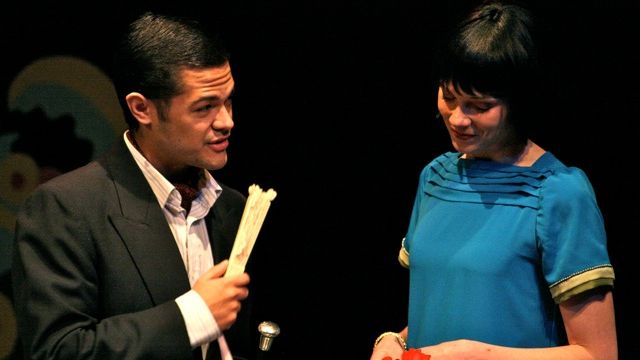Lady Windermere’s Fan
Oscar Wilde famously thought he knew how to use wit to get by in a suffocating and hypocritical moral era. In this classic, he uses his experience to set up poor Lady Windermere, in her naïveté initially the most morally rigid of the characters, to fall foul of her own strictures.
It’s a brilliant play, and it deserves a clever treatment. Tony Turner’s take is startlingly good, bringing out all the subtleties, subtexts and undercurrents as written, while making several changes designed to make it more accessible to a modern audience. One of these is neat editing, for instance cutting out explicatory sentences which these days would appear clunky. In doing this, Turner shows confidence in his cast to convey meaning through action, and some of the most expressive moments come through clever dialogue play—hesitations rich with unspoken meaning, lines delivered simultaneously, and action in complete silence. Zoe Tuffin played Lady Windermere naturalistically—at times she seemed a little held back, perhaps by nervousness, but as she warmed into the role she conveyed a strong façade slowly cracking to reveal Lady Windermere’s devastation. Ross Walker’s Lord Windermere plays innocent straight man to the comics around him. Mrs Erlynne is a tightrope of a role, and Christa de Jager portrays with dignity and charm this woman who has clawed her way back from social ruin, only to risk it all. The supporting cast shows the depth of amateur acting talent in Canberra, with witty lines perfectly delivered aplenty, especially Liz Bradley whose Duchess of Berwick was a joy.
Another Turner modernisation was to bring the setting forward from the late 1800s to 1925. This works as not only are modern audiences more familiar with the 1920s, but it’s almost the latest period in time when the language matches seamlessly, Wilde having influenced such famous wits as Saki (H.H. Monro) and Noël Coward. Choosing this period has allowed the designers to go to town with gorgeous Art Deco lines, picking up on the Chinoiserie fad for the furnishings, and using a tea set which could almost be Clarice Cliff. An evening party scene, spilling from the interior out to a terrace, is fabulously evoked by set designer Quentin Mitchell’s free standing Art Deco wall with inset uplights, and Chris Ellyard’s use of a string of cheery coloured rice paper lamps and subtle use of lighting to differentiate inside from the night outdoors. Special mention must be made of the costumes, which were nothing short of spectacular—certainly the best I’ve seen in a play this year. The level of detailing, down to embroidered borders, sumptuous fabric choice and colours, even sewn fabric flowers on period bonnets, made for a breathtaking display, and fixes the setting firmly in the 1920s. This is amateur theatre at its best.
Cathy Bannister
Photo: Adrian Flor as Lord Darlington and Zoe Tuffin as Lady Windermere. Photo by Helen Drum.
Subscribe to our E-Newsletter, buy our latest print edition or find a Performing Arts book at Book Nook.

